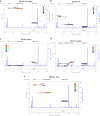Evaluation of the MC4R gene across eMERGE network identifies many unreported obesity-associated variants
- PMID: 32952152
- PMCID: PMC7752751
- DOI: 10.1038/s41366-020-00675-4
Evaluation of the MC4R gene across eMERGE network identifies many unreported obesity-associated variants
Abstract
Background/objectives: Melanocortin-4 receptor (MC4R) plays an essential role in food intake and energy homeostasis. More than 170 MC4R variants have been described over the past two decades, with conflicting reports regarding the prevalence and phenotypic effects of these variants in diverse cohorts. To determine the frequency of MC4R variants in large cohort of different ancestries, we evaluated the MC4R coding region for 20,537 eMERGE participants with sequencing data plus additional 77,454 independent individuals with genome-wide genotyping data at this locus.
Subjects/methods: The sequencing data were obtained from the eMERGE phase III study, in which multisample variant call format calls have been generated, curated, and annotated. In addition to penetrance estimation using body mass index (BMI) as a binary outcome, GWAS and PheWAS were performed using median BMI in linear regression analyses. All results were adjusted for principal components, age, sex, and sites of genotyping.
Results: Targeted sequencing data of MC4R revealed 125 coding variants in 1839 eMERGE participants including 30 unreported coding variants that were predicted to be functionally damaging. Highly penetrant unreported variants included (L325I, E308K, D298N, S270F, F261L, T248A, D111V, and Y80F) in which seven participants had obesity class III defined as BMI ≥ 40 kg/m2. In GWAS analysis, in addition to known risk haplotype upstream of MC4R (best variant rs6567160 (P = 5.36 × 10-25, Beta = 0.37), a novel rare haplotype was detected which was protective against obesity and encompassed the V103I variant with known gain-of-function properties (P = 6.23 × 10-08, Beta = -0.62). PheWAS analyses extended this protective effect of V103I to type 2 diabetes, diabetic nephropathy, and chronic renal failure independent of BMI.
Conclusions: MC4R screening in a large eMERGE cohort confirmed many previous findings, extend the MC4R pleotropic effects, and discovered additional MC4R rare alleles that probably contribute to obesity.
Conflict of interest statement
The authors declare that they have no conflict of interest.
Figures

Similar articles
-
Investigation of a genome wide association signal for obesity: synthetic association and haplotype analyses at the melanocortin 4 receptor gene locus.PLoS One. 2010 Nov 15;5(11):e13967. doi: 10.1371/journal.pone.0013967. PLoS One. 2010. PMID: 21085626 Free PMC article.
-
The genetic epidemiology of melanocortin 4 receptor variants.Eur J Pharmacol. 2011 Jun 11;660(1):156-64. doi: 10.1016/j.ejphar.2011.01.033. Epub 2011 Feb 2. Eur J Pharmacol. 2011. PMID: 21295023 Review.
-
Association of the 103I MC4R allele with decreased body mass in 7937 participants of two population based surveys.J Med Genet. 2005 Apr;42(4):e21. doi: 10.1136/jmg.2004.027011. J Med Genet. 2005. PMID: 15805150 Free PMC article.
-
The role of common and rare MC4R variants and FTO polymorphisms in extreme form of obesity.Mol Biol Rep. 2014 Mar;41(3):1491-500. doi: 10.1007/s11033-013-2994-4. Epub 2014 Jan 3. Mol Biol Rep. 2014. PMID: 24385306
-
Melanocortin pathways: suppressed and stimulated melanocortin-4 receptor (MC4R).Physiol Res. 2020 Sep 30;69(Suppl 2):S245-S254. doi: 10.33549/physiolres.934512. Physiol Res. 2020. PMID: 33094623 Free PMC article. Review.
Cited by
-
Predisposition of the Common MC4R rs17782313 Female Carriers to Elevated Obesity and Interaction with Eating Habits.Genes (Basel). 2023 Oct 25;14(11):1996. doi: 10.3390/genes14111996. Genes (Basel). 2023. PMID: 38002939 Free PMC article.
-
Using Phecodes for Research with the Electronic Health Record: From PheWAS to PheRS.Annu Rev Biomed Data Sci. 2021 Jul 20;4:1-19. doi: 10.1146/annurev-biodatasci-122320-112352. Annu Rev Biomed Data Sci. 2021. PMID: 34465180 Free PMC article. Review.
-
Molecular Analysis and Conformational Dynamics of Human MC4R Disease-Causing Mutations.Molecules. 2022 Jun 23;27(13):4037. doi: 10.3390/molecules27134037. Molecules. 2022. PMID: 35807283 Free PMC article.
-
Genetics, genomics, and diet interactions in obesity in the Latin American environment.Front Nutr. 2022 Dec 1;9:1063286. doi: 10.3389/fnut.2022.1063286. eCollection 2022. Front Nutr. 2022. PMID: 36532520 Free PMC article. Review.
-
Genetics Evaluation Outcomes From an Academic Multidisciplinary Atypical Diabetes Program.J Endocr Soc. 2025 Jun 5;9(8):bvaf091. doi: 10.1210/jendso/bvaf091. eCollection 2025 Aug. J Endocr Soc. 2025. PMID: 40585884 Free PMC article.
References
-
- Fan W, Boston BA, Kesterson RA, Hruby VJ, Cone RD. Role of melanocortinergic neurons in feeding and the agouti obesity syndrome. Nature. 1997;385:165–8. - PubMed
-
- Huszar D, Lynch CA, Fairchild-Huntress V, Dunmore JH, Fang Q, Berkemeier LR, et al. Targeted disruption of the melanocortin-4 receptor results in obesity in mice. Cell. 1997;88:131–41. - PubMed
-
- Weide K, Christ N, Moar KM, Arens J, Hinney A, Mercer JG, et al. Hyperphagia, not hypometabolism, causes early onset obesity in melanocortin-4 receptor knockout mice. Physiol Genom. 2003;13:47–56. - PubMed
Publication types
MeSH terms
Substances
Grants and funding
- U01 HG006385/HG/NHGRI NIH HHS/United States
- U01 AI130830/AI/NIAID NIH HHS/United States
- U01 HG008657/HG/NHGRI NIH HHS/United States
- U01 HG006382/HG/NHGRI NIH HHS/United States
- U01 HG004424/HG/NHGRI NIH HHS/United States
- U01 HG006389/HG/NHGRI NIH HHS/United States
- U01 HG008679/HG/NHGRI NIH HHS/United States
- U01 HG006380/HG/NHGRI NIH HHS/United States
- P30 AR070549/AR/NIAMS NIH HHS/United States
- U01 HG008673/HG/NHGRI NIH HHS/United States
- U01 HG008685/HG/NHGRI NIH HHS/United States
- U01 HG006379/HG/NHGRI NIH HHS/United States
- U01 HG008664/HG/NHGRI NIH HHS/United States
- U01 HG006375/HG/NHGRI NIH HHS/United States
- U01 HG004438/HG/NHGRI NIH HHS/United States
- U01 HG008684/HG/NHGRI NIH HHS/United States
- U01 HG006828/HG/NHGRI NIH HHS/United States
- R01 AI024717/AI/NIAID NIH HHS/United States
- U01 HG008666/HG/NHGRI NIH HHS/United States
- U01 HG006388/HG/NHGRI NIH HHS/United States
- U01 HG008680/HG/NHGRI NIH HHS/United States
- P50 HD103537/HD/NICHD NIH HHS/United States
- U01 HG006378/HG/NHGRI NIH HHS/United States
- I01 BX001834/BX/BLRD VA/United States
- U01 HG008701/HG/NHGRI NIH HHS/United States
- U01 HG006830/HG/NHGRI NIH HHS/United States
LinkOut - more resources
Full Text Sources
Medical
Miscellaneous

